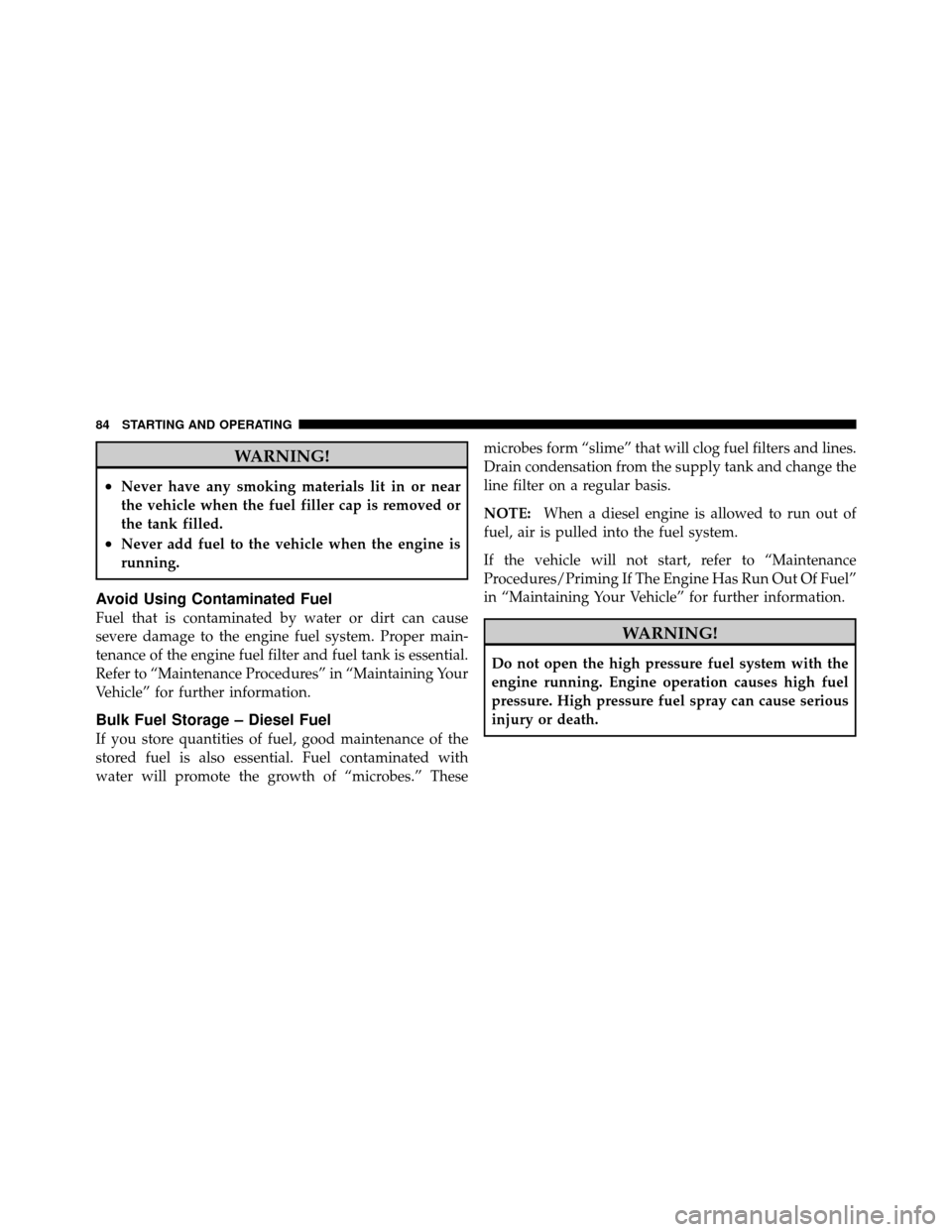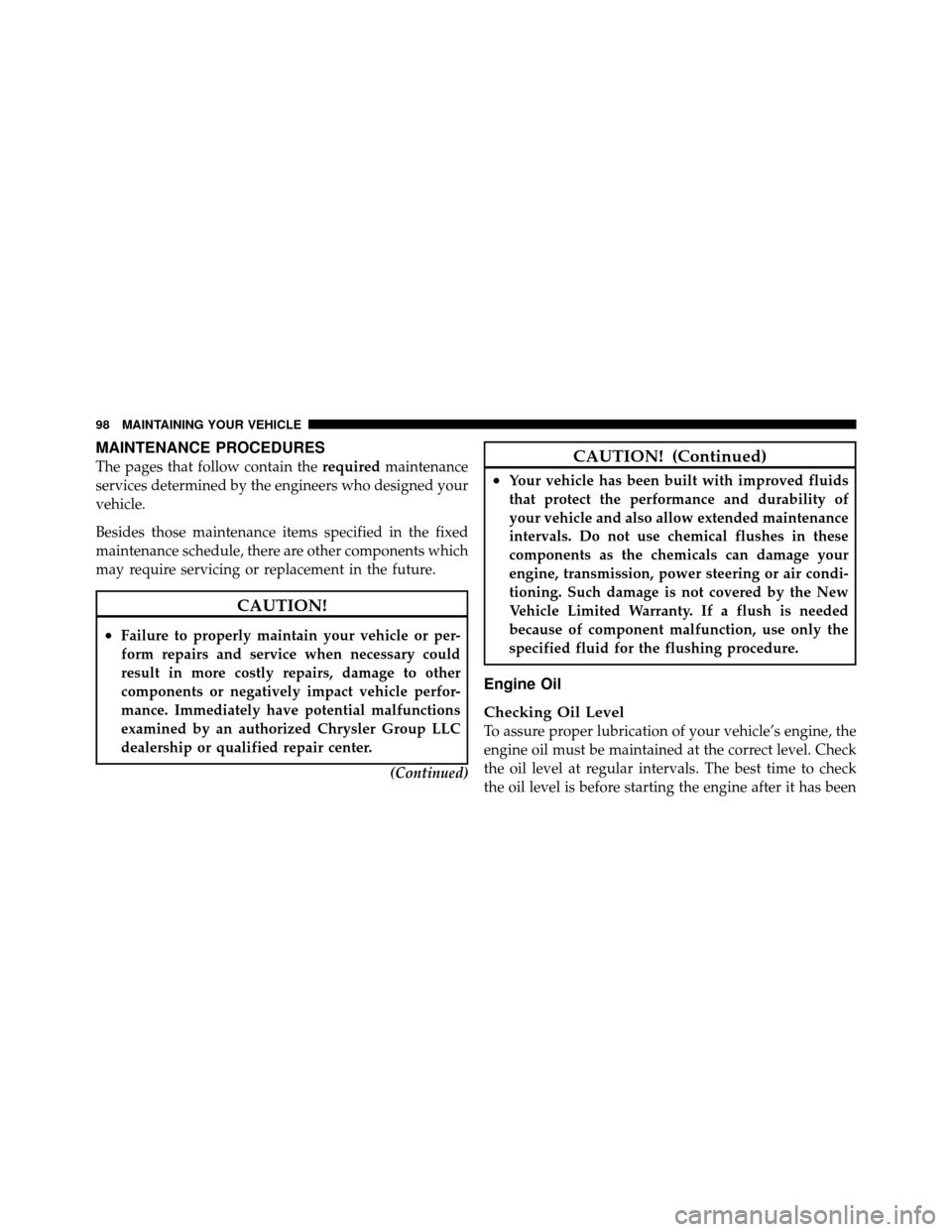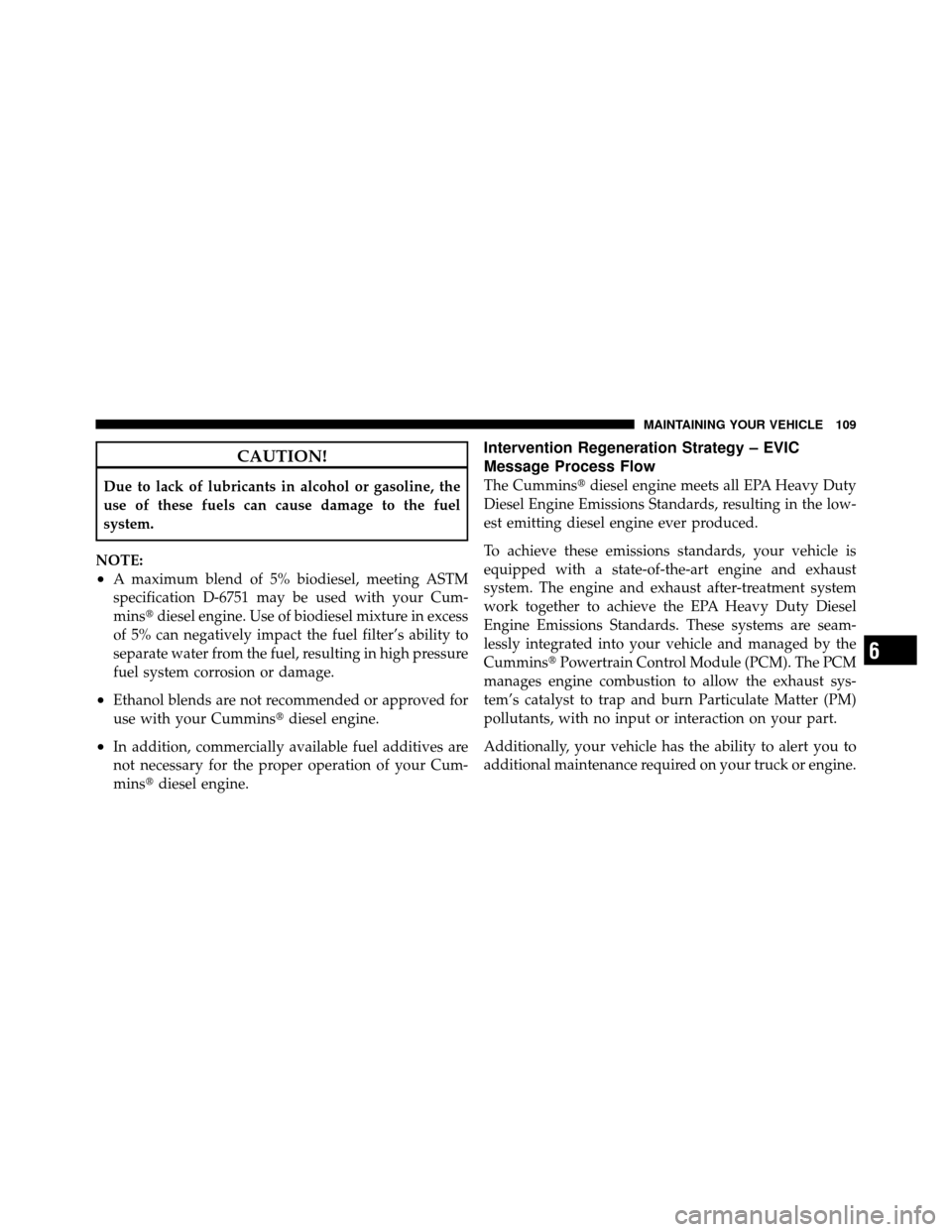Page 54 of 170

NOTE:For EVIC messages related to the vehicle’s
exhaust system, refer to “Maintenance Procedures/
Intervention Regeneration Strategy – EVIC Message Pro-
cess Flow” in “Maintaining Your Vehicle” for further
information.
Idle-Up Feature – Automatic Transmission Only
The driver-controlled high idle speed feature will help
increase cylinder temperatures and provide additional
cab heat, however, excessive idling may still cause the
exhaust aftertreatment system to not properly regenerate.
Extended periods of idle time should be avoided.
The Idle-Up feature uses the speed control switches to
increase engine idle speed and quickly warm the vehi-
cle’s interior.
1. With the transmission in PARK, the parking brake
applied, and the engine running, press the speed control
switch to the ON position, then press the SET switch. 2. The engine RPM will go up to 1100 RPM. To increase
the RPM, press and hold the ACCEL/RESUME switch
and the idle speed will increase to approximately 1500
RPM. To decrease the RPM, press and hold the DECEL
switch and the idle speed will decrease to approximately
1100 RPM.
3. To cancel the Idle–Up feature, either press the CAN-
CEL switch, press the ON/OFF switch, or press the brake
pedal.
Stopping The Engine
Idle the engine a few minutes before routine shutdown.
After full load operation, idle the engine three to five
minutes before shutting it down. This idle period will
allow the lubricating oil and coolant to carry excess heat
away from the combustion chamber, bearings, internal
components, and turbocharger. This is especially impor-
tant for turbocharged, charge air-cooled engines.
4
STARTING AND OPERATING 53
Page 85 of 170

WARNING!
•Never have any smoking materials lit in or near
the vehicle when the fuel filler cap is removed or
the tank filled.
•Never add fuel to the vehicle when the engine is
running.
Avoid Using Contaminated Fuel
Fuel that is contaminated by water or dirt can cause
severe damage to the engine fuel system. Proper main-
tenance of the engine fuel filter and fuel tank is essential.
Refer to “Maintenance Procedures” in “Maintaining Your
Vehicle” for further information.
Bulk Fuel Storage – Diesel Fuel
If you store quantities of fuel, good maintenance of the
stored fuel is also essential. Fuel contaminated with
water will promote the growth of “microbes.” Thesemicrobes form “slime” that will clog fuel filters and lines.
Drain condensation from the supply tank and change the
line filter on a regular basis.
NOTE:
When a diesel engine is allowed to run out of
fuel, air is pulled into the fuel system.
If the vehicle will not start, refer to “Maintenance
Procedures/Priming If The Engine Has Run Out Of Fuel”
in “Maintaining Your Vehicle” for further information.
WARNING!
Do not open the high pressure fuel system with the
engine running. Engine operation causes high fuel
pressure. High pressure fuel spray can cause serious
injury or death.
84 STARTING AND OPERATING
Page 96 of 170
MAINTAINING YOUR VEHICLE
CONTENTS
�Engine Compartment — 6.7L Diesel ......... 97
� Maintenance Procedures .................. 98
▫ Engine Oil .......................... 98
▫ Engine Air Cleaner Filter ............... 102
▫ Draining Fuel/Water Separator Filter ...... 104
▫ Priming If The Engine Has Run Out Of
Fuel .............................. 108
▫ Intervention Regeneration Strategy – EVIC
Message Process Flow ................. 109
▫ Diesel Exhaust Fluid – Chassis Cab Only . . . 112 ▫
Maintenance-Free Batteries ............. 112
▫ Cooling System ..................... 113
▫ Charge Air Cooler – Inter-Cooler ......... 119
▫ Brake System ....................... 119
▫ Clutch Hydraulic System ............... 121
▫ Transfer Case – If Equipped ............. 121
▫ Manual Transmission – If Equipped ....... 121
▫ Automatic Transmission – If Equipped ..... 122
▫ Noise Control System Required Maintenance
& Warranty ........................ 125
6
Page 99 of 170

MAINTENANCE PROCEDURES
The pages that follow contain therequiredmaintenance
services determined by the engineers who designed your
vehicle.
Besides those maintenance items specified in the fixed
maintenance schedule, there are other components which
may require servicing or replacement in the future.
CAUTION!
•Failure to properly maintain your vehicle or per-
form repairs and service when necessary could
result in more costly repairs, damage to other
components or negatively impact vehicle perfor-
mance. Immediately have potential malfunctions
examined by an authorized Chrysler Group LLC
dealership or qualified repair center.
(Continued)
CAUTION! (Continued)
•Your vehicle has been built with improved fluids
that protect the performance and durability of
your vehicle and also allow extended maintenance
intervals. Do not use chemical flushes in these
components as the chemicals can damage your
engine, transmission, power steering or air condi-
tioning. Such damage is not covered by the New
Vehicle Limited Warranty. If a flush is needed
because of component malfunction, use only the
specified fluid for the flushing procedure.
Engine Oil
Checking Oil Level
To assure proper lubrication of your vehicle’s engine, the
engine oil must be maintained at the correct level. Check
the oil level at regular intervals. The best time to check
the oil level is before starting the engine after it has been
98 MAINTAINING YOUR VEHICLE
Page 100 of 170
parked overnight. When checking oil after operating the
engine, first ensure the engine is at full operating tem-
perature, then wait for 30 minutes after engine shutdown
to check the oil.Checking the oil while the vehicle is on level ground will
improve the accuracy of the oil level readings. Add oil
only when the level on the dipstick is below the “ADD”
mark. The total capacity from the low mark to the high
mark is 2 qts (1.9L).
CAUTION!
Overfilling or underfilling the crankcase will cause
oil aeration or loss of oil pressure. This could damage
your engine.
Never operate the engine with oil level below the “ADD”
mark or above the upper “SAFE” mark.
Change Engine Oil
Refer to “Maintenance Schedule” for the proper mainte-
nance intervals.
1 — ADD Range
2 — Full Mark
3 — SAFE Range
6
MAINTAINING YOUR VEHICLE 99
Page 103 of 170

Synthetic Engine Oils
You may use synthetic engine oils provided the recom-
mended oil quality requirements are met, and the recom-
mended maintenance intervals for oil and filter changes
are followed.
Materials Added to Engine Oil
The manufacturer strongly recommends against the ad-
dition of any additives (other than leak detection dyes or
lube odorants) to the engine oil. Engine oil is an engi-
neered product and its performance may be impaired by
supplemental additives.
Engine Oil Filter
Refer to “Fluids, Lubricants, and Genuine Parts” in
“Maintaining Your Vehicle” for further information. The
engine oil filter should be changed at every engine oil
change.
Disposing Of Used Engine Oil And Filter
Care should be taken in disposing of the used engine
fluids from your vehicle. Used fluids, indiscriminately
discarded, can present a problem to the environment.
Contact an authorized dealer, service station, or govern-
mental agency for advice on recycling programs and
where used fluids and filters can be safely discarded in
your area.
Engine Air Cleaner Filter
CAUTION!
All air entering the engine intake must be filtered.
The abrasive particles in unfiltered air will cause
rapid wear to engine components.
The condition of the air cleaner filter is monitored by the
Engine Control Module. The “SERVICE AIR FILTER”
102 MAINTAINING YOUR VEHICLE
Page 110 of 170

CAUTION!
Due to lack of lubricants in alcohol or gasoline, the
use of these fuels can cause damage to the fuel
system.
NOTE:
•A maximum blend of 5% biodiesel, meeting ASTM
specification D-6751 may be used with your Cum-
mins� diesel engine. Use of biodiesel mixture in excess
of 5% can negatively impact the fuel filter’s ability to
separate water from the fuel, resulting in high pressure
fuel system corrosion or damage.
•Ethanol blends are not recommended or approved for
use with your Cummins� diesel engine.
•In addition, commercially available fuel additives are
not necessary for the proper operation of your Cum-
mins�diesel engine.
Intervention Regeneration Strategy – EVIC
Message Process Flow
The Cummins� diesel engine meets all EPA Heavy Duty
Diesel Engine Emissions Standards, resulting in the low-
est emitting diesel engine ever produced.
To achieve these emissions standards, your vehicle is
equipped with a state-of-the-art engine and exhaust
system. The engine and exhaust after-treatment system
work together to achieve the EPA Heavy Duty Diesel
Engine Emissions Standards. These systems are seam-
lessly integrated into your vehicle and managed by the
Cummins� Powertrain Control Module (PCM). The PCM
manages engine combustion to allow the exhaust sys-
tem’s catalyst to trap and burn Particulate Matter (PM)
pollutants, with no input or interaction on your part.
Additionally, your vehicle has the ability to alert you to
additional maintenance required on your truck or engine.
6
MAINTAINING YOUR VEHICLE 109
Page 111 of 170

Refer to the following messages that may be displayed on
your Electronic Vehicle Information Center (EVIC):
WARNING!
A hot exhaust system can start a fire if you park over
materials that can burn. Such materials might be
grass or leaves coming into contact with your exhaust
system. Do not park or operate your vehicle in areas
where your exhaust system can contact anything that
can burn.
Perform Service
Your vehicle will require emissions maintenance at a set
interval. To help remind you when this maintenance is
due, the Electronic Vehicle Information Center (EVIC)
will display “Perform Service”. When the “Perform Ser-
vice” message is displayed on the EVIC it is necessary to
have the emissions maintenance performed. Emissionsmaintenance may include replacing the Closed Crank-
case Ventilation (CCV) filter element, and cleaning of the
EGR Cooler. The procedure for clearing and resetting the
�Perform Service�
indicator message is located in the
appropriate Service Information.
Exhaust System – Regeneration Required Now
“Exhaust System — Regeneration Required Now” will be
displayed on the Electronic Vehicle Information Center
(EVIC) if the exhaust particulate filter reaches 80% of its
maximum storage capacity. Under conditions of exclu-
sive short duration and low speed driving cycles, your
Cummins� diesel engine and exhaust after-treatment
system may never reach the conditions required to re-
move the trapped PM. If this occurs, the “Exhaust System
— Regeneration Required Now” message will be dis-
played in the EVIC. If this message is displayed, you will
hear one chime to assist in alerting you of this condition.
110 MAINTAINING YOUR VEHICLE